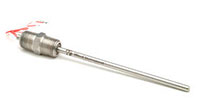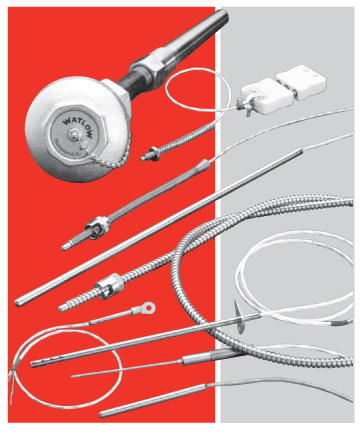When Watlow thermocouple sensors measure a device or material’s temperature, the open side is exposed to heat, creating a thermoelectric circuit through the wires. The circuit cannot flow freely because the wires are not joined at both ends, though, so electricity escapes through the broken end.
The voltage that the thermocouple releases, which is called its electromotive force, reflects the medium’s temperature, which is calculated through an equation. A higher EMF reading reflects a higher temperature.
Depending on the type of junction your thermocouple sensors have, you may not be able to see the wires. With grounded and ungrounded junctions, the wires are inside the sheath. Grounded wires are welded to their sheaths, while ungrounded ones are insulated from the sheath. Wires with exposed junctions are outside their sheaths, exposing them to corrosion but also allowing them to read temperatures more quickly.
Thermocouples are industrial temperature sensors which involve a device that is compatible with thermocouples, a thermocouple thermometer, and two wires that join both devices. These wires, which are connected on one side, are not the same length, so they do not meet at the open end.
They can function as probes that have sheaths protecting the wires, surface probes that measure the exterior of solids, or beaded wire models that feature wires welded together. Different models offered by Watlow distributors such as Hi-Watt are appropriate based on the medium you are measuring and whether you want a surface or interior reading.
A thermistor sensor is a resistance thermometer highly sensitive to small changes in temperature and is an economical means of precisely sensing heat over a limited range of temperatures. These sensors utilize a metal oxide whose change in resistance is typically an inverse function of the change in temperature.
RTD temperature sensors have between two and four lead wires. These wires are insulated and connected to a resistance element, or the part that increases in resistance as the wires heat up. Copper, platinum, and nickel are all popular choices for the resistance element.
As the wires get hotter, they transfer heat to the resistance element. One of the basic laws of thermodynamics is that metals’ resistance to electricity increases as they warm up, a characteristic known as a positive temperature coefficient.
The external device calculates the substance’s temperature based on how resistant the metal has become, which involves converting Ohms to degrees Fahrenheit. This conversion formula varies based on the resistance element’s material and positive temperature coefficient.
A resistance temperature detector is a passive temperature sensor. As the temperature goes up, so does an RTD’s resistance, which a different device can measure by sending a tiny amount of electricity through the RTD. Because the ratio of temperature increase to resistance increase is constant, this conversion process is simple.
Thermocouples’ temperature sensors use two wires welded together to gauge a substance’s temperature. These wires are made of different metals and are only joined at one end. The difference in metals produces an electrical circuit when they encounter cold or hot substances, and the thermocouple’s thermometer converts the voltage into a temperature reading.
Different thermocouple sensors take their readings in different ways. Some probes’ sheaths can simply be removed to start measuring, while others must be submerged in the material in question. Similarly, the formula for turning voltage units into degrees varies.
A thermocouple sensor is a specialized temperature measure that provides accurate readings in settings where normal thermometers can’t function well. Probes, beaded wire thermocouples, and surface probes are some of the most common types of thermocouple sensors, and their design reflects the type of measurements they can take. For example, we recommend using a probe when you need to check the air’s temperature.


